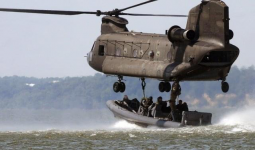- Reaction score
- 7,438
- Points
- 1,360
Not the Onion ....




More on the idea here.The C-130J is an incredibly versatile aircraft, and since it’s creation, it’s landed on rough fields, in arctic locations and even an aircraft carrier Yet, it cannot land on water, which covers about 71% of the planet. As national strategic objectives shift focus to littoral regions, Air Force Special Operations Command is advancing new approaches to expand the multi-mission platform's runway independence and expeditionary capacity.
In partnership with the Air Force Research Lab's Strategic Development Planning and Experimentation (AFRL-SDPE) directorate, AFSOC is developing an MC-130J Commando II Amphibious Capability (MAC) to improve the platform's support of seaborne special operations. "The development of the MAC capability is the culmination of multiple lines of effort," said Lt Col Josh Trantham, AFSOC Science, Systems, Technology, & Innovation (SST&I) Deputy Division Chief. "This capability allows the Air Force to increase placement and access for infiltration, exfiltration, and personnel recovery, as well as providing enhanced logistical capabilities for future competition and conflict." ...








